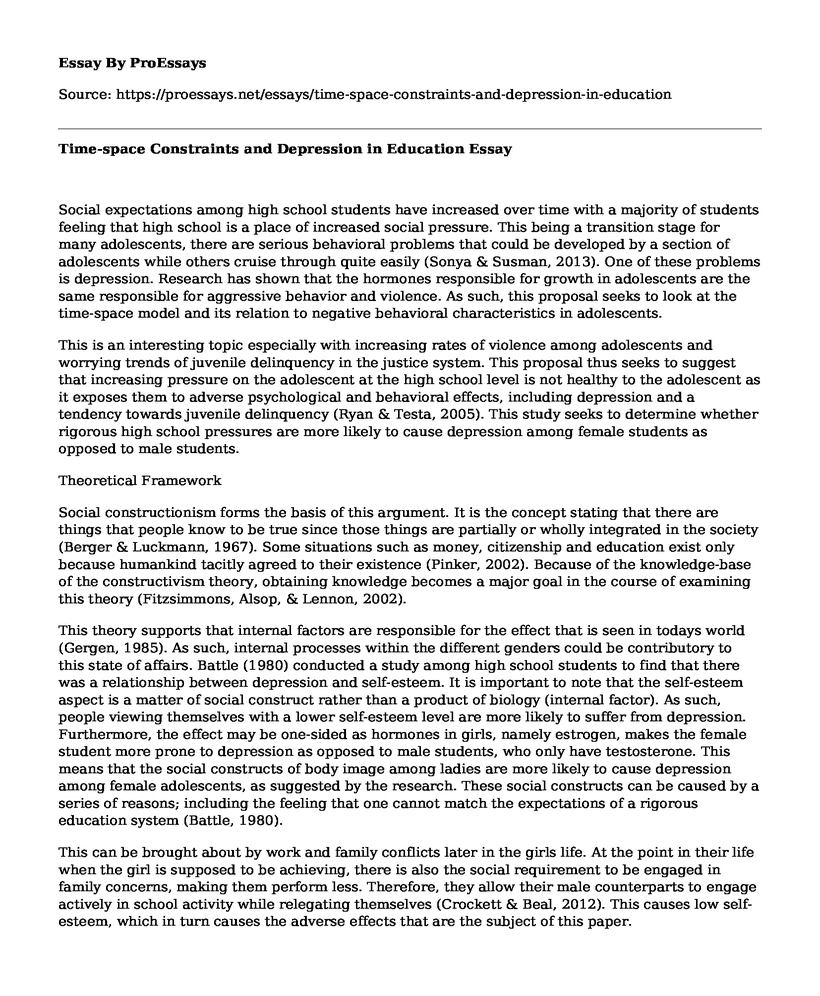Social expectations among high school students have increased over time with a majority of students feeling that high school is a place of increased social pressure. This being a transition stage for many adolescents, there are serious behavioral problems that could be developed by a section of adolescents while others cruise through quite easily (Sonya & Susman, 2013). One of these problems is depression. Research has shown that the hormones responsible for growth in adolescents are the same responsible for aggressive behavior and violence. As such, this proposal seeks to look at the time-space model and its relation to negative behavioral characteristics in adolescents.
This is an interesting topic especially with increasing rates of violence among adolescents and worrying trends of juvenile delinquency in the justice system. This proposal thus seeks to suggest that increasing pressure on the adolescent at the high school level is not healthy to the adolescent as it exposes them to adverse psychological and behavioral effects, including depression and a tendency towards juvenile delinquency (Ryan & Testa, 2005). This study seeks to determine whether rigorous high school pressures are more likely to cause depression among female students as opposed to male students.
Theoretical Framework
Social constructionism forms the basis of this argument. It is the concept stating that there are things that people know to be true since those things are partially or wholly integrated in the society (Berger & Luckmann, 1967). Some situations such as money, citizenship and education exist only because humankind tacitly agreed to their existence (Pinker, 2002). Because of the knowledge-base of the constructivism theory, obtaining knowledge becomes a major goal in the course of examining this theory (Fitzsimmons, Alsop, & Lennon, 2002).
This theory supports that internal factors are responsible for the effect that is seen in todays world (Gergen, 1985). As such, internal processes within the different genders could be contributory to this state of affairs. Battle (1980) conducted a study among high school students to find that there was a relationship between depression and self-esteem. It is important to note that the self-esteem aspect is a matter of social construct rather than a product of biology (internal factor). As such, people viewing themselves with a lower self-esteem level are more likely to suffer from depression. Furthermore, the effect may be one-sided as hormones in girls, namely estrogen, makes the female student more prone to depression as opposed to male students, who only have testosterone. This means that the social constructs of body image among ladies are more likely to cause depression among female adolescents, as suggested by the research. These social constructs can be caused by a series of reasons; including the feeling that one cannot match the expectations of a rigorous education system (Battle, 1980).
This can be brought about by work and family conflicts later in the girls life. At the point in their life when the girl is supposed to be achieving, there is also the social requirement to be engaged in family concerns, making them perform less. Therefore, they allow their male counterparts to engage actively in school activity while relegating themselves (Crockett & Beal, 2012). This causes low self-esteem, which in turn causes the adverse effects that are the subject of this paper.
Next steps and Conclusion
With serious concerns being raised about increased juvenile delinquency levels, perhaps the best option is to reduce the rigor engaged with high school students and learning approaches that boos self-esteem among students, especially female students. This study seeks to contribute to the literature of both education and sociology, drawing a relationship between learning cultures in school and adverse emotional and psychological effects in adolescent learners.
References
Battle, J. (1980). Relationship between self-esteem and depression among high school students. Perceptual and Motor Skills, 51.
Berger, P., & Luckmann, t. (1967). The social construction of reality: a treatise on the sociology of knowledge. London: Penguin Publishers.
Crockett, L., & Beal, S. (2012). The life course in the making: gender and the development of adolesscents expected timing of adult role transitions. Developmental Psychology, 1727-38.
Fitzsimmons, A., Alsop, R., & Lennon, K. (2002). Theorizing Gender. New York: Polity Press.
Gergen, J. (1985). The social constructionist movement in modern psychology. American Psychologist, 266-75.
Pinker, S. (2002). The blank slate: the modern denial of human nature. New York: Penguin Books.
Ryan, J., & Testa, M. (2005). Child Maltreatment and juvenile deliquency: investigating the role of placement and placement instability. Children and Youth Services Review, 1-35.
Sonya, N., & Susman, E. (2013). Pubertal Timing, Depression, And Externalizing Problems: A Framework, Review, And Examination Of Gender Differences. Journal Of Research On Adolescence, 717-46.
Cite this page
Time-space Constraints and Depression in Education. (2021, Mar 11). Retrieved from https://proessays.net/essays/time-space-constraints-and-depression-in-education
If you are the original author of this essay and no longer wish to have it published on the ProEssays website, please click below to request its removal:
- The Character of the Teenage Girl in Sweet Town - A Literary Essay Sample
- Title IX Debate: The Issue of the Inclusion of College Football
- Essay Example on a College Student's Struggle With Early Risers
- Adolescents ALSPH Suicide: Mixed-Method Study - Essay Sample
- Essay Example on Online Learning and the Future of Libraries
- Job Stress: A Growing Problem in Asia and Yemen - Essay Sample
- Child Development & Growth: Professional Caregiver Guidelines - Essay Sample







